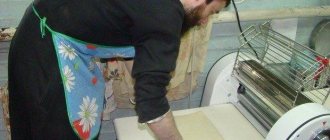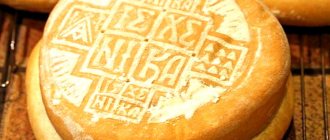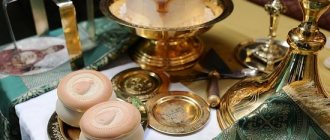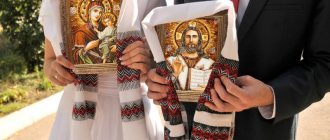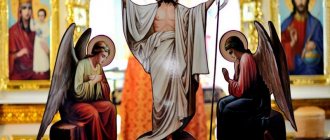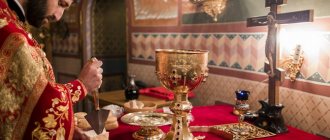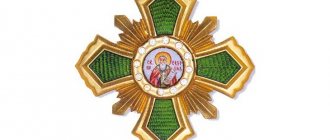Artos is considered a special bread that is associated with the greatest miracle - the Resurrection of Jesus Christ. This shrine is distributed to believers only once a year - during the Easter period. Therefore, it is not surprising that the Orthodox always want to receive this shrine.
The word artos is translated from Greek as “leavened bread” - consecrated bread common to all members of the Church, otherwise - whole prosphora. Artos, throughout Bright Week, occupies the most prominent place in the church, together with the icon of the Resurrection of the Lord, and, at the end of Easter celebrations, is distributed to believers.
Artos: what is this?
The use of this miracle bread began at the very beginning of Christianity, on the day when Jesus Christ ascended to heaven.
His believing disciples and those who followed him were very worried about his death and consoled themselves with the help of various prayers, in which they remembered his every action (word, step). When they prayed, together remembering the secret evening meeting, they always took communion at the same time. When getting ready to eat, they deliberately left an empty place at their table, and they always put bread for the invisible but present Lord.
When the shrine is distributed
In the Orthodox tradition, artos is blessed on Easter - leavened bread of special consecration. Those who could not receive communion on Easter could feel unity through eating common bread. Now artos is distributed to believers to keep at home for a year; it is customary to eat it on an empty stomach in case of illness. In the church, every Orthodox believer can receive an artos on the 6th day of Bright Week.
The tradition of distributing artos bread dates back to the time of the apostles. After Jesus was resurrected on the 40th day, he ascended to Heaven, and his followers found comfort in the memories of Him and everything connected with Him. During the common prayer, the apostles remembered the Last Supper, and the first place at the table was empty. This is due to the fact that it was intended for the Teacher, and bread was placed in this place.
Artos bread is a symbol of the fact that Jesus Christ accepted all the sins that people have committed. Thanks to such bread, people receive proof that the Savior is always invisibly nearby. The artos depicts a cross and a crown of thorns, and this reminds people that Jesus managed to defeat death. The bread resembles prosphora, but it is only larger in size.
Belief
An ancient church tradition is also associated with this product. It lies in the fact that the apostles at the table left a small part of the bread - this was the share of the Mother of God. In this way they reminded themselves of constant communication with her and after eating, they shared this part among themselves with all trepidation. In all monasteries this tradition is called the “Rite of Panagia”, which means remembrance of the Mother of God. In parish churches this is done once a year; the custom is associated with the crushing of the artos.
It is consecrated with a special prayer, sprinkled with holy water, and on the first day of Easter they go to all liturgies, as soon as the prayer behind the pulpit, which is read by the priest himself, ends. It is so called because to pronounce it, the reader descends from a raised platform in front of the altar, the outermost projection of which is called the pulpit. But usually the priest, in order to read the prayer behind the pulpit, does not descend, but stands on it, because from this elevation everything is perfectly audible to those present in the church.
Easter bread artos is placed on the salt (this is such a raised platform in front of the iconostasis in the Orthodox Church, as if a continuation of the altar), opposite the royal doors, on a specially prepared table. And a special prayer is read for the sacrament of its fragmentation. During this ritual, there is a deacon (this is a church minister who helps the priest conduct the rituals, but does not have the right to perform them independently), parishioners and, of course, the priest. The prayer he reads talks about the miracle created by Christ, when he fed the needy people with five loaves of bread, despite all their illnesses and sins. People ask the Holy Trinity for the sacred artos to give health to the body and internal state. They praise God and thank him for his endless kindness and love for people.
After the bread is blessed, it, together with the stand on which it lies, is placed on a raised platform in front of the image of the Savior himself. The bread is there throughout Holy Week.
Artos is taken on all days of this holiday. We’ll find out how to use it correctly a little later. When the liturgy with the sacred Easter cake ends, a religious procession is held around the temple in a solemn atmosphere. On Saturday, after the prayer behind the pulpit, another prayer is read - for grinding the artos. It is broken up at the very end of the liturgy, when the cross is kissed, after which it is distributed to everyone present as a shrine, then a prayer is read for the acceptance of the artos. It says that bread and water, prepared in a special way in church with certain prayers and mood, can strengthen a person’s health and fortitude. He believes that he can become a better person with the help of God, who treats people mercifully, as the saints and the Mother of God pray for all humanity.
Those small particles (antidor) of the holy bread that were distributed in the church are very carefully kept at home in a corner next to the icons.
When artos is taken out and distributed
Artos is placed in front of the open Royal Doors on the Easter holiday itself. It is consecrated at the Easter liturgy after the prayer behind the pulpit, then incense is performed and the artos is sprinkled with holy water.
This consecrated bread lies in front of the open Royal Doors throughout Bright Week. Every day of the holiday week there is a religious procession around the temple with artos. After this, the artos is placed in its original place in front of the altar.
On Bright Saturday, artos is divided by the clergy and distributed to all believers in a small piece. On this day, parishioners should have a bag with them so as not to drop the crumbs of the holy bread.
Ritual
For a very long time there has been a tradition of sewing small bags with drawstrings in order to carry and store prosphora. If you have one, then there is no need for any bags, and you will no longer be afraid that the blessed bread may be dropped or forgotten somewhere. And in the moment of some kind of trouble, you can take out the artos with peace of mind. These bags are called prosphora bags or prosphora bags; they are often very beautifully decorated with rhinestones or beads, various embroideries and ribbons. You can sew them yourself or buy them in church shops.
Many parishioners who have recently come to thoughts about God and decided to devote their lives to prayers for their family and friends do not know the rules and wonder what kind of bread this is - artos, and how to take it correctly. Now let's try to understand this matter a little.
Why is artos needed?
Artos is the consecrated bread through which we can experience the joy of Easter throughout the year. It reminds us of the festive spirit that reigned during Bright Week. By eating a piece of artos, we renew our body and soul and elevate our spirit.
The attitude towards artos should be reverent; you should not litter its crumbs. For a long time, bread played a special role in Rus'. They treated it with respect, tried not to litter it, not to drop it, because the work of many people was associated with it. In addition, when reading the prayer “Our Father,” where we ask for our daily bread, any bread on the table is blessed. Therefore, even bread crumbs were collected and eaten or given to the birds.
Bread at the Liturgy is of great importance; it is transformed into the Body of Christ. In honor of the Blessed Virgin Mary there is a special bread called “Panagia”. In some monasteries the rite of Panagia still exists, i.e. exaltation of bread in honor of the Most Pure One. This is how important attention is paid to simple bread in the Orthodox environment.
Moreover, artos is a special bread blessed for Easter. And the attitude towards him should be special. This is a gift that is offered to God in honor of His resurrection.
Artos bread: how to eat it?
Believers take all prayers and pieces of sacred bread very seriously, therefore, when they bring it into their home, they dry it and store it strictly in some jar or box. Artos is bread that can only be used for special needs, for example, during a severe illness or out of hopelessness, when misfortune comes one after another, for peace of mind. The sacred product is eaten only on an empty stomach, washed down with holy water!
So we learned about artos, that it is a great shrine and plays a big role in the life of Christians. But in order to properly crush it into small particles, it must first be baked. This is the recipe for baking great bread.
How does arthos heal?
The process of preparing, consecrating, crushing and distributing artos is accompanied by prayers in the temple and fills the Shrine with healing properties. Being holy bread, artos requires careful treatment and no less reverent and moderate use. The consecration of the artos is carried out in honor of the Resurrection of the Lord and in honor of the memory of this event. The prayer itself for the consecration of the artos contains requests to saturate the bread with the ability to heal ailments and infirmities of the soul and body and protect all who eat from illness. The priest asks the Lord God for a blessing to saturate the bread with God's grace. Artos, like other Holy Bread, is filled with great power, but it would be a mistake to exaggerate the potential of artos particles. It would be a mistake to consider artos as a soul-saving holy food, the eating of which replaces serious Sacraments. Communion of the sick person with the Blood and Body of Christ is not equivalent to receiving artos and Epiphany water. This should always be remembered. No Shrine replaces the Sacrament, but it is a vessel of grace, blessed to help the sick.
Photo from the website krest-sobor.ru
Artos is a medicine that heals the soul and body in difficult cases, allowing you to relieve pain and calm passions. But it is important to remember that receiving artos cannot replace receiving Communion. Artos is similar in effect to Epiphany water. By accepting the holy bread with prayer, faith and gratitude, one can expect a relief from the suffering of the body and hope to calm the torment of the soul. And the complete saving effect will be ensured by constant visiting of the temple, participation in divine services and acceptance of the Sacraments performed in the temple. Since artos is a Shrine with great potential, it is advised to save it for special situations and eat it less often than, for example, antidor. It is worth eating artos every day only during rehabilitation after operations and long periods of illness. The maximum healing effect is provided by artos together with other Shrines. For example, eating artos, holy water, particles of prosphora together with anointing with oil and prayers to the icons of Orthodox Wonderworkers contributes to a speedy healing. Holy bread with rich symbolism connects everything that a person needs for the health of body and soul. When eating artos, it is recommended not to forget about its filling with grace and understand that holy bread is less of a bodily food, and plays an important role as spiritual food.
https://blagozdravnica.ru/artos-istoki-traditsii-razdrobleniya-i-simvolika-svyaty-ni/
Recipe
Take 1 kg 200 g of flour, preferably premium quality. Pour a little holy water into the bottom of the bowl where the dough will be kneaded. Pour in 400 g of flour and pour over very hot water. This is done to impart sweetness and resistance to mildew. Mix everything and cool. Then add salt, having previously diluted it in holy water, and add 25 g of yeast. Mix everything well and wait 30 minutes. Next, add flour (800 g) and mix again. As soon as the dough has risen, place it on the table and roll it out with a rolling pin into sheets of the required thickness.
Cut into circles; for the lowest part of the artos, make a larger circle. Then cover with a damp towel, and then with a dry one, and wait another 30 minutes. A stamp is placed on the top. Then both parts need to be lubricated with warm water and connected. Pierce both parts to prevent voids from forming. Then place on a baking sheet and bake in the oven until done. Small ones are baked for 15 minutes, service ones - about 20 minutes.
How to cook artos
The recipe for making artos at home is very simple, however, some housewives make their own adjustments to make the Easter bread tasty. But real artos must be prepared according to a method approved by the clergy. Afterwards the bread must be consecrated in the temple.
Ingredients:
- 21 g fresh yeast;
- 1.5 tbsp. l. salt;
- 900 ml cold water;
- 500 ml hot water;
- 4 liters of flour.
Preparation:
- Crumble fresh yeast into a bowl, add salt, pour in cold water, and stir.
- Then add 100 ml of hot water and mix well again until smooth.
- Sift a 1 liter ladle of flour into a bowl, pour in 400 ml of hot water, stir.
- Now add the remaining flour and pour the yeast mixture through a sieve.
- Knead the dough, put it in a bag and let it rest for 15 minutes.
- Afterwards, roll out the dough into a layer 2.5 cm thick and use any round shape to cut out the bottom of the bread. We put it in a bag.
- Then we assemble it again, roll it out to a thickness of 1 cm and cut out the top part for the bread using the same shape that we used for the bottom.
- On the top part we put a seal with the image of a cross and a wreath; you can also use seals with other Easter symbols.
- We also put the bread lids in a bag and leave for a while.
- Afterwards, we connect the lower and upper parts with ordinary water and make several punctures with a skewer.
- Bake the artos for 40 minutes, gradually increasing the temperature from 100 to 140°C.
- Afterwards, remove the bread from the mold, place it on a baking sheet and continue baking until golden brown at the bottom and top.
- Cover the finished Easter bread with a towel and leave for an hour.
For reference! In monasteries, artos is baked using wholemeal flour. Also, to knead the dough, the monks take 1 glass of regular boiled water and 1 glass of holy water. According to this ancient recipe, you can bake bread at home, but only after the blessing of the priest.
How to take and store arthos correctly
All believers reverently keep the resulting piece of artos in the temple as a spiritual medicine that helps to heal any infirmity and disease.
Church bread must be stored away from prying eyes. Most often they try to leave it near the icons. You can store it in a plastic bag. But in order to observe all traditions correctly, such bread must be stored in linen bags.
If someone desecrates the artos, it will quickly deteriorate. Because of this, it is customary to store it only in dried form and in a bag.
Church bread has some healing properties. That is why artos must be used in certain situations, for example, when a person is sick or needs help. Before using artos, you must say the following words: “Christ is risen!”
In addition, every believer has the right to eat artos in the morning on an empty stomach and wash it down with holy water. Most often it is used during the celebration of Easter.
Source
How and when to eat artos
This consecrated bread must be eaten at special and difficult moments in life in order to participate in the joy of Easter. For example, during times of illness or pain, when the mind and body are especially tired. By eating a piece of artos, we revive the tired spirit and make it able to aspire to God, but do not confuse it with Holy Communion or Antidore.
Artos must be eaten on an empty stomach, having first read the prayer for accepting prosphora and holy water. After the prayer, add the words: “Christ is risen! He is truly risen! "You can sing the Easter troparion. We should try not to fall apart when we eat artos.
Prosphora - what is it and what is it for?
Prosphora is a small bread that has a round shape. It is prepared from wheat dough , which is kneaded in holy water. Several facts are known about this treat:
- the word “prosphora” is translated from Greek as “offering”;
- Apart from yeast and salt, no additives are added to such baked goods;
- in the Orthodox Church it is believed that such baked goods consist of two parts, which symbolize the fusion of human and divine essence united in Jesus Christ;
- On top of the bread there is a seal in the shape of a cross, which have equal sides. In the corners there are the letters IC XC NI K. A. Such an inscription means “Jesus Christ conquers,” and the seal is the personification of the invisible seal of the image of the Lord;
- depicts the prosphora bread of the Last Supper , which Jesus divided among the disciples.
What is the symbol of artos?
The first church pastors established the placing of bread in the temple on the feast of the Resurrection of Christ. This was done as a unique expression of the fact that the Savior, who suffered for people, became the true bread in life for everyone. On the artos you can see a cross with a crown of thorns. However, there is no crucifixion.
Artos has an ancient tradition, according to which the apostles left part of the bread at the table as the Lord's share. In the monastery, this custom has its own name: the Rite of Panagia - remembrance of the Mother of Jesus.
What to do if artos has gone bad
After you bring home a piece of artos, you need to chop it up and dry it so that it does not spoil. Keep it open. Some people put it in an open jar, okay.
If artos becomes moldy, it should not be thrown into the trash. The flowering shoot should be thrown into an open reservoir with running water (into the river, but not into the lake). He then tells the priest about this sin in confession.
Artos - Orthodox Dictionary
Holidays and fasts The first and second finding of the head of the Prophet and Forerunner In total, the Church celebrates three finding of the honest head 0 184
Holidays and fasts Second week of Great Lent After the week of the Triumph of Orthodoxy comes the Second week 0 369
Other “Distance learning” for the children of Father Pavel Florensky Name of an outstanding theologian, brilliant scientist and researcher 0 382


